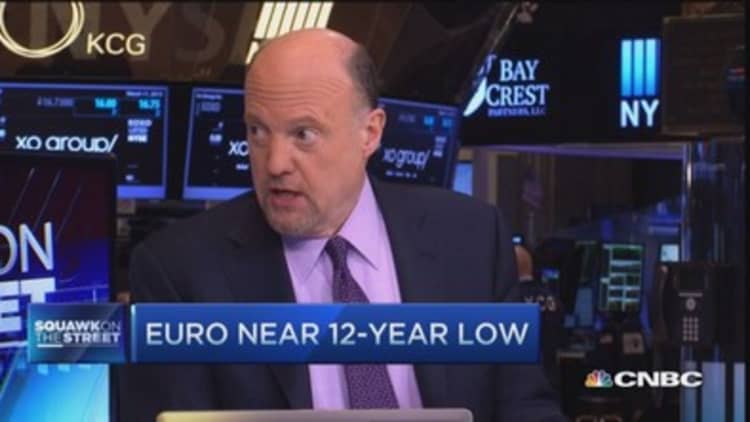
If you've ever thought about taking that grand European vacation you've always dreamed of, now may be a great time. In the last year, the euro has lost nearly a quarter of its value versus the U.S. dollar. The slide in value for the euro zone's shared currency now puts it at a level we haven't seen in nearly 12 years, and American tourists could be among the biggest beneficiaries.
While the concepts around foreign exchange and currency markets may seem daunting for many, the core ideas are relatively easy to understand. When a currency like the dollar appreciates, it's able to buy more stuff that's priced in currencies outside our borders. When a currency loses value, it isn't able to buy as much. In this case, the dollar's gain relative to the euro means that greenback-based consumers have more purchasing power to buy things denominated in euros.
Let's say a hotel room in Paris costs300 euros. It would have cost you around $415 to pay that a year ago, when euros cost $1.385. That same 300 euro room would only cost $318 today with euros costing $1.06. Imagine saving $100 per night on your hotel room, and then applying that same level of savings to taxi fares, dinners out, museum admission fees, etc. That's why seasoned travelers are licking their chops for a chance to take a trip across the Atlantic.
Read MoreBMW anybody? Carmakers to gain most from weak euro
However, the price levels you're seeing in euros on CNBC and in newspapers around the world won't necessarily be the price you'll get when you actually go on vacation. It all depends on how you go about buying euros.
The way that many travelers convert their dollars into euros involves using a currency-exchange kiosk or store at the airport or your mall. While this option may be convenient, it can be costly. For instance, according to retail currency exchange giant Travelex, a euro costs $1.1969, despite the current interbank market rates of $1.06.
That means it costs 13 percent more to buy your currency there than what's indicated in the market. Retail foreign-exchange kiosks do represent an efficient way to get your hands on cash immediately, but just be prepared to pay more.
Other options can be more cost effective. Many travel experts will advise using credit cards to do the bulk of your spending when on vacation, and for good reason. The rates that banks and credit card companies use in converting foreign currency charges to dollars is much more favorable than retail currency shops, but there are also fees to be aware of. All of these factors affect what ultimately shows up on your credit card statement after you've spent money in a foreign currency.
Read MorePrepare for euro-dollar parity—and fast
For instance, American Express charges a 2.7 percent foreign transaction fee for any purchases made outside the U.S. That's on top of whatever the prevailing exchange rate is for converting your purchase to dollars. When asked about how the exchange rate is calculated, the company's customer service representatives referred us to website www.x-rates.com.
The site arrives at an exchange rate based upon what it says is a "commercial grade rate feed, which blends rates from a large array of independent sources." A check of rates provided by the website revealed that they were very close to current market levels. So, with a credit card like American Express, you can expect a transparent exchange rate that's close to current market levels, along with a foreign transaction fee.

Another option involves using your bank-issued debit card for purchases, or withdrawing money from a bank ATM when abroad. According to online bank Ally Financial, its customers can use their bank issued MasterCard debit cards without any fees being charged by the bank itself. However, MasterCard still charges its own foreign transaction fees. Ally says that pursuant to its customer deposit agreement, those fees are capped at 1 percent.
MasterCard sets the foreign currency conversion rate for purchases, and those rates are also very close to the current market. Its currency conversion tool can be found here for customer reference. Withdrawing money from a local bank ATM is also a more efficient option, though you will be assessed fees by not only the foreign bank, but possibly your own financial institution as well. Ally notes that it does not charge those fees for its customers.
Other banks and credit card payment networks charge their own schedule of fees, so it's worth investigating which options are best given what's in your wallet, or what's appropriate for your individual financial situation.
Read MoreNowhere but down? Euro reacts to QE
More sophisticated travelers who also like dabbling in the financial markets also have other tools to help manage the potential cost of a European vacation. For professional traders, speculating on, or hedging against currency moves can be done trading the actual currencies themselves. A big caveat is that foreign exchange trading should only be done by those who understand the risks.
Often, trades in the currency market are also done on a leveraged basis, meaning borrowed money is used to amplify returns. While the possibility for outsized gains exists, so does the possibility for outsized losses that could potentially wipe out the value of trading accounts.
A simpler way to hedge the risks associated with your European vacation may lie in the exchange traded fund, or ETF market. The CurrencyShares Euro ETF is managed by Guggenheim Investments and currently has approximately $226 million in assets. The fund is designed to track the price of the euro currency versus the dollar.
Read MoreECB begins bond-buying: What should you do?
The price change in the fund closely mirrors the change in euro value, so can be used as a proxy for actually buying and selling the currency itself. For those fortunate enough to have the money budgeted and set aside for a future vacation, one simple way to lock in the cost could be to buy shares in the ETF.
For example, assume you've budgeted $1,000 to spend while you are in Paris. If you're content with the current value of the dollar against the euro, you could take that cash and invest it in the fund. If the value of euros heads higher in the coming months before your trip, you will have generated profits on the fund position that can help offset the relative rise in the cost of your vacation.
Meanwhile, if the euro continues to fall, you'll have lost money on your fund position, offset by the relative savings you'll have by a cheaper euro to use on your vacation. Of course, trading ETFs involves managing market risk and trading commissions, which are just a couple of considerations for this type of activity.
No matter what, there will always be market risks associated with spending in any currency that's not what you deal with at home. However, doing some homework about how to spend your money, and how to hedge your exposure may give you a little extra spending money on that well-deserved holiday—all made possible by the greenback's staggering winning streak.


